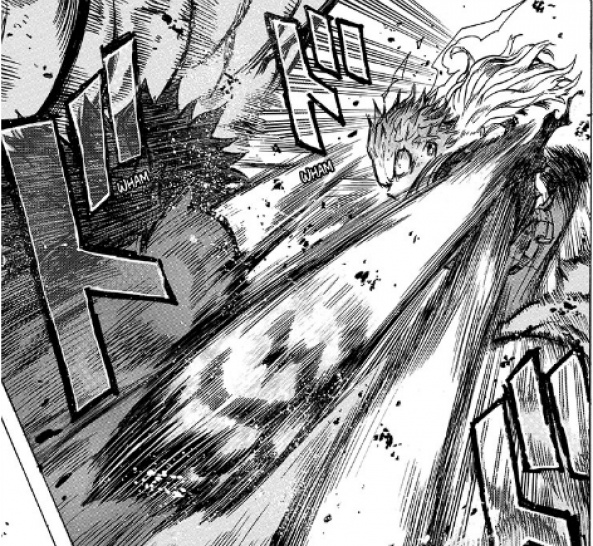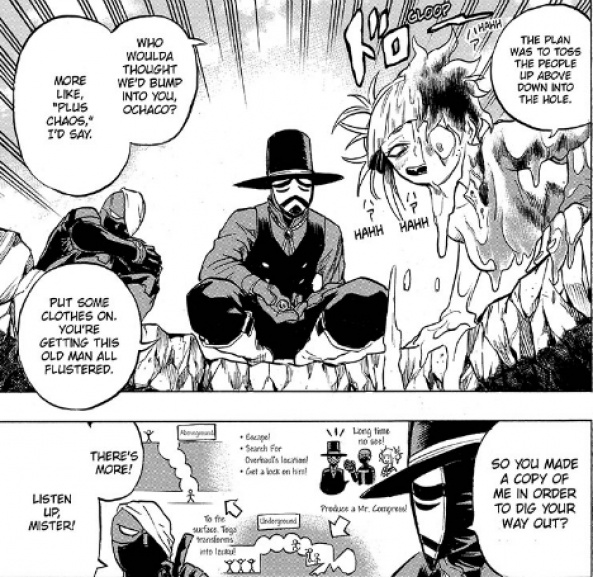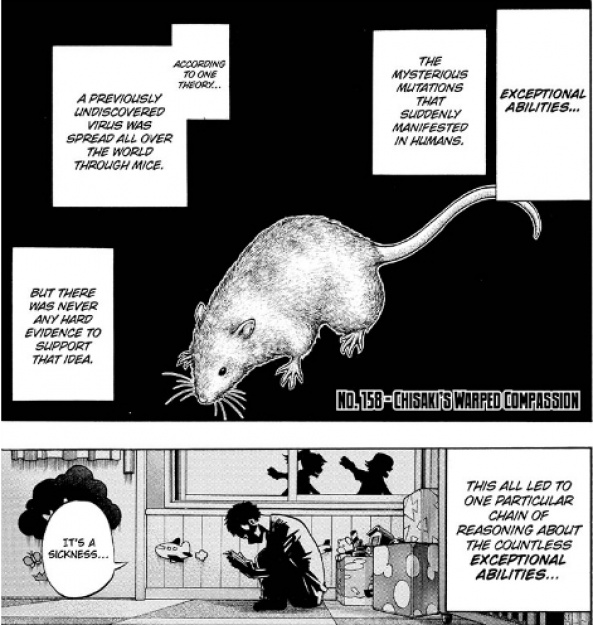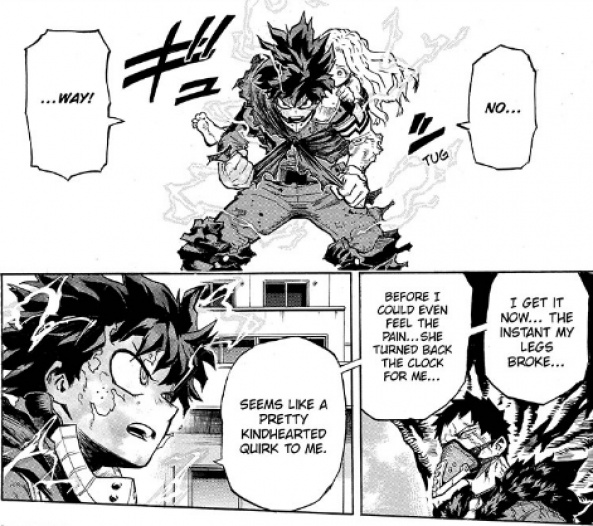Another month of mangaka Kōhei Horikoshi’s “My Hero Academia” has come and gone – with a full compliment of 4 chapters to digest – and still the current arc has yet to reach a definitive conclusion. While the most recent chapter certainly ended with a smash, we’ll have to wait until next month’s chapters to see if the combined efforts of Deku and Eri were enough to subdue Overhaul, or to force him into fleeing at the very least.

This showdown however, while extensive by the series’ own standards, has been filled with multifaceted and layered conflict. Horikoshi has ambitiously managed a situation that is being contested by three parties, each of varying numbers, mentalities and goals. The clash of wills on display, driven by vastly opposing philosophies, has undoubtedly made for a gripping read for weeks and months on end. The first asset of this complex situation, which I wish to touch upon, are the motivations of the two villain groups; with a particular focus given to the young leader of the Shie Hassaikai – and the primary villain of the arc – Overhaul.
Firstly though, the role of the League of Villains members – Twice and Toga – should not be underestimated. Their involvement in this arc, from Chapter 146 onwards, has been a treat. The unique and adaptable nature of their quirks, in addition to their fascinatingly unhinged personalities, has truly injected a dose of ‘Plus Chaos’ into an already hectic mix. The unpredictable nature of their actions, typified by their willingness to momentarily aid the heroes as long as it helped to sabotage the plans of the Hassaikai, has allowed the situation to shift in a number of unexpected, yet gripping, directions.
But the desire shown by this pair, to act in the interest of making Overhaul pay (primarily for killing their comrade Magne), has served an even greater purpose. Their willingness to risk everything in order to achieve this revenge, which was encouraged by their leader Tomura Shigaraki, signifies the noteworthy growth of three things: Shigaraki as a figurehead, the group as a whole, and the relationships that bind its members together. This kind of development for an antagonistic faction, seen so relatively early on in the prospective scope of a series, is simply refreshing and worthy of praise. Overhaul however, especially as seen in the latest batch of chapters, is where Horikoshi’s ability to write complex character motivations truly shines.

Delving further into the young gangster’s past in recent chapters, and thus obtaining a greater understanding of his motivations, has been thoroughly intriguing to me. After all, it was made clear from his initial appearance in Chapter 115, that Overhaul’s motif revolved around the interesting theme of illness and disease (as seen through his plague doctor-like design, and his dialogue when faced with others who are brandishing their quirks). His interactions since that point have played into this very theme in a number of ways, and yet the very latest material has subsequently inverted immediate expectations, as a result of Overhaul’s evidently warped compassion.
When starting to look at this depth of writing – in relation to character motivation – the first thing that must be understood is Overhaul’s two-fold association with quirks and illness. The first has been seen on numerous occasions, but is most noticeable during the yakuza’s fight with Lemillion. This association can be summarised as Overhaul believing that quirks give individuals false hope, and as such this delusional mind-set held by society is warped and needs curing.
The second has only come to light in the most recent chapter, but it is something that relates to an underlying question regarding the “My Hero Academia” universe since the very first chapter of the series. The origin of quirks is possibly the biggest mystery yet to be solved in this series, and Chapter 158 presents one theory held by inhabits of this world; that a previously undiscovered virus was spread all over the world by mice, ushering in the age of quirks. The nature of this particular theory appears to have led some believers – like a young Overhaul – to see the advent of quirks not only as the foundation for a diseased mentality built upon delusions of grandeur, but also as a literal sickness that requires curing.
Continued below
With this most recent viewpoint in mind, the reasoning behind Overhaul’s plans appears to become clearer for the readers. Through his yakuza connections, Overhaul happened upon the young girl Eri, whose quirk had the ability to rewind. After further research however, it becomes clear to the man that he is able to extract blood from the girl and engineer it in such a fashion that the ‘rewind’ can be streamlined, with a person’s quirk factor as the intended target. This gives Overhaul the potential to possess a tool that can indeed cure the two-fold sickness that he sees, surrounding quirks, on a permanent basis. And yet while this combination of the villain’s hang-up, resolve, and subsequent method to overcome the aforementioned hang-up would act as a perfectly serviceable chain of characterisation for Overhaul, Horikoshi does not stop there.
In my opinion, Horikoshi manages to elevate the quality of Overhaul’s character hugely with a revelation made in Chapter 158, as the mangaka includes inner turmoil and conflicting interests that really accentuate the concern surrounding Overhaul’s mental state. This inversion of expectations is brought about by the existence of a serum, also developed by Overhaul, that is capable of bringing back any quirks that would have been rewound by Overhaul’s initial scientific breakthrough. While creating such a thing may seem hugely contradictory to Overhaul’s ambitions on the surface, a flashback displaying more of Overhaul’s interactions with the old (now bedridden) boss of the Hassaikai, demonstrates perfectly the juxtaposed goals he possesses. Whilst Overhaul would happily try to bring about an end to all quirks, considering his own feelings on the matter (a message which he indeed portrays externally, in the presence of the heroes who look to thwart him), he clearly considers the debt he owes the old boss – for having taken him in – to be of more importance than fulfilling his personal ambitions.
This departure from the norm – to have Overhaul willingly disregard his own wishes, in order to repay the old boss of the Hassaikai by enabling a revival of the Yakuza – makes for a fascinating read. And still Horikoshi is not done yet, with developing the complexity of the situation surrounding the actions taken by Overhaul. After all, the experiments that Overhaul performs on the young girl Eri (the old boss’s granddaughter) in order to develop the two products needed to rock the foundation of the society of quirks – thus allowing the Hassaikai to monopolistically control the market for the two quirk-related products – were heavily scrutinised by the old boss himself. So instead of either giving up on the experiments at the boss’s request, or re-directing his efforts into achieving his own goals, Overhaul takes a third path; through which he seemingly puts the old boss into a comatose state, and continues with his warped interpretation of the old boss’s dreams to revive the Yakuza. This level of attention to detail shown by Horikoshi, in regard to the sheer intricacy of Overhaul’s actions and motivations (both internally and externally), is certainly a highlight for me during the current arc, and I can’t wait to see what else he is capable of doing with characters in this story, moving forward.

So while the motivations of the arc’s villains have been incredibly compelling, it would be remiss of me to ignore the actions of series’ protagonist Deku. During these analyses, I have certainly heaped praise on Horikoshi for his handling of the heroes other than Deku during this arc. But now that the main character is back in the spotlight, Horikoshi certainly doesn’t disappoint in detailing subtle improvements that Deku has made as a hero thus far. While some may immediately jump to the action-packed segments of the most recent chapters, when discussing Deku’s shining moments (and I agree that Deku’s ingenious use of Eri’s quirk, as a loophole to utilise 100% of One For All, giving us a look at just what kind of power he may wield in the future independently, is something to be admired), I’ll instead look to highlight the words he says and the decisions he makes; outside of combat.
The single decision that Deku makes – in the heat of the moment – which stands out to me, is his instruction to Uravity (who along with the rest of the Ryukyu agency, just crashed down into the chaos from above) to get Nighteye to safety. This split-second shift of responsibility, allowing for Deku to focus entirely on rescuing Eri from Overhaul’s clutches (which after all, is the true goal of the heroes’ mission), demonstrates a very realistic perspective from Deku. While it is clear that Deku’s long-term goal is to be a hero who can save everybody, he is aware of the fact that he currently isn’t capable of doing so. By making this decision so swiftly, it cements both Deku’s realistic viewpoint on his current standing as a prospective hero, in addition to the trust he has in his classmates and fellow heroes, which speaks volumes about Deku as a relatable character whom is easy to rally around.
Continued belowIn regards to the noteworthy dialogue involving Deku, Chapter 157 is well worth examining. There are two examples seen in this chapter, that I believe are worthy of particular attention, as they again demonstrate leaps forward that Deku has made toward becoming the hero he wants to be. The first is when Deku – after experiencing Eri’s quirk first-hand – calls it a kind-hearted quirk, which juxtaposes with Overhaul’s own description of the quirk as cursed. These compassionate words, something that given Eri’s upbringing she is unlikely to have ever heard, understandably bring the girl to tears. Deku’s mature and considerate words for the young girl do not stop there though. Immediately afterwards, instead of utilising Eri as a tool to access more of his power than he should really be able to at this point, Deku asks the girl if she would lend him a hand. This simple gesture indicating teamwork between the two – to confront this menacing presence that has plagued the girl’s life – as opposed to simply using her as a means to an end, says a lot about Deku as both a character and more importantly as a hero. These straightforward actions should not be underestimated though, as these are the moments that demonstrate Deku’s ability to save not only people, but their hearts and minds too, which is a far cry from Deku’s performance during the rescue portion of the Provisional License Exam.

So as you can see, from my comments so far, I have thoroughly enjoyed this month’s chapters for a multitude of reasons. I am still very much looking forward to the arc’s conclusion, however, as the aftermath of such a tumultuous event will be intriguing to see unfold. After all, we’re not quite sure what’ll come of: the League of Villain’s involvement, where the potential defeat of Overhaul would leave yakuza members like Rappa, what will happen to Eraserhead following his kidnapping at the hands of Chronostasis, the wellbeing of Suneater, Red Riot, Lemillion and Nighteye, the future of Eri within the narrative, and also the public reception to what is likely Deku’s first official foray into the world of pro heroics.
Before I finish up though, I would just like to show my appreciation for the artistic talent displayed by Horikoshi (which while it is normally of great quality, the mangaka seems to have surpassed even his own high standards as of late). His detailed drawings have unquestionably elevated the excitement felt by the high-octane action, and the emotion felt through the evocative facial expressions. Horikoshi’s use of panelling has been nothing less than phenomenal, with a particular page of Overhaul’s reaching hand acting as the panel borders acting as the stand out instance of this. Finally, his firm grasp on the environments in which the characters find themselves have allowed for engaging conflict, with realistic movement and decision-making on all sides. Deku’s Manchester Smash, Overhaul’s deconstruction of nearby buildings, and Deku’s 100% kick to Overhaul – that sent him soaring into the sky above the surrounding residential area – all serve as perfect examples of this artistic prowess from Horikoshi.

And with that, I’ll wrap up this latest instalment of Go Beyond. Thanks again for checking in, and I hope you too have enjoyed the most recent batch of “My Hero Academia” chapters. Given the sheer quality of this month’s offerings, I honestly can’t wait to see where we stand at this time next month, so I hope you’ll all join me again then for another ‘Plus Ultra’ analysis.






